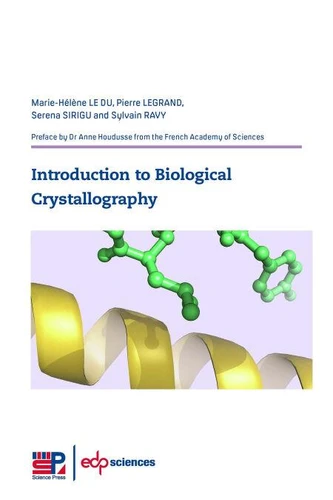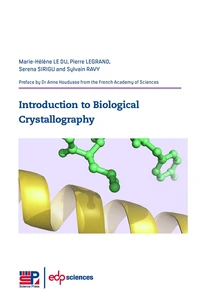M. -H. Le Du est chercheur au CEA.
Introduction to Biological Crystallography
Par : , , ,Formats :
Disponible dans votre compte client Decitre ou Furet du Nord dès validation de votre commande. Le format PDF est :
- Compatible avec une lecture sur My Vivlio (smartphone, tablette, ordinateur)
- Compatible avec une lecture sur liseuses Vivlio
- Pour les liseuses autres que Vivlio, vous devez utiliser le logiciel Adobe Digital Edition. Non compatible avec la lecture sur les liseuses Kindle, Remarkable et Sony
 , qui est-ce ?
, qui est-ce ?Notre partenaire de plateforme de lecture numérique où vous retrouverez l'ensemble de vos ebooks gratuitement
Pour en savoir plus sur nos ebooks, consultez notre aide en ligne ici
- Nombre de pages156
- FormatPDF
- ISBN978-2-7598-3502-7
- EAN9782759835027
- Date de parution01/08/2024
- Protection num.Digital Watermarking
- Taille23 Mo
- Infos supplémentairespdf
- ÉditeurEDP Sciences
Résumé
In the living world, the mechanisms that make us breathe, digest, grow or move an arm involve molecules made up of thousands of atoms, called macromolecules. These macromolecules are constantly circulating, interacting and deforming. Visualising these macromolecules at the atomic level is a unique tool for understanding their function and for designing drugs, inhibitors or activators. When using the three-dimensional structure of a macromolecule, it is essential to keep a critical eye.
To do this, we need to understand how the structure was obtained. X-ray crystallography is a historical method of using X-rays and crystals to determine the three-dimensional atomic structure of molecules. It is also the most widely used. The main audience for this book is biological scientists, although it will appeal to anyone interested in structural biology. It introduces the different steps involved in biological crystallography, from crystallisation to the determination of the three-dimensional structure of a macromolecule.
Thanks to the videos available through the QR codes at the end of each chapter, sites normally closed to the public are opened up to offer you a unique journey to the heart of life.
To do this, we need to understand how the structure was obtained. X-ray crystallography is a historical method of using X-rays and crystals to determine the three-dimensional atomic structure of molecules. It is also the most widely used. The main audience for this book is biological scientists, although it will appeal to anyone interested in structural biology. It introduces the different steps involved in biological crystallography, from crystallisation to the determination of the three-dimensional structure of a macromolecule.
Thanks to the videos available through the QR codes at the end of each chapter, sites normally closed to the public are opened up to offer you a unique journey to the heart of life.
In the living world, the mechanisms that make us breathe, digest, grow or move an arm involve molecules made up of thousands of atoms, called macromolecules. These macromolecules are constantly circulating, interacting and deforming. Visualising these macromolecules at the atomic level is a unique tool for understanding their function and for designing drugs, inhibitors or activators. When using the three-dimensional structure of a macromolecule, it is essential to keep a critical eye.
To do this, we need to understand how the structure was obtained. X-ray crystallography is a historical method of using X-rays and crystals to determine the three-dimensional atomic structure of molecules. It is also the most widely used. The main audience for this book is biological scientists, although it will appeal to anyone interested in structural biology. It introduces the different steps involved in biological crystallography, from crystallisation to the determination of the three-dimensional structure of a macromolecule.
Thanks to the videos available through the QR codes at the end of each chapter, sites normally closed to the public are opened up to offer you a unique journey to the heart of life.
To do this, we need to understand how the structure was obtained. X-ray crystallography is a historical method of using X-rays and crystals to determine the three-dimensional atomic structure of molecules. It is also the most widely used. The main audience for this book is biological scientists, although it will appeal to anyone interested in structural biology. It introduces the different steps involved in biological crystallography, from crystallisation to the determination of the three-dimensional structure of a macromolecule.
Thanks to the videos available through the QR codes at the end of each chapter, sites normally closed to the public are opened up to offer you a unique journey to the heart of life.





